RAM (Random Access Memory) and ROM (Read-Only Memory) are two types of primary memory. This article aims to explain the difference between RAM and ROM.
Computer memory works similarly to a human brain. It is an electronic holding place for data and instructions a CPU ( Central Processing Unit ) needs to access for program execution. Memory is among the basic functions of a computer . Without it, a computer system would not have any place to store information or data.
There are three different types of memory – cache memory, primary memory, and secondary memory .
- Primary memory is the computer's main memory, storing essential instructions and data a CPU needs to execute programs or tasks.
- Cache memory stores data and instructions that are frequently used by the CPU.
- Secondary memory is the permanent storage medium storing data until a user deletes it.
This article focuses on the difference between the types of primary memory – RAM and ROM.
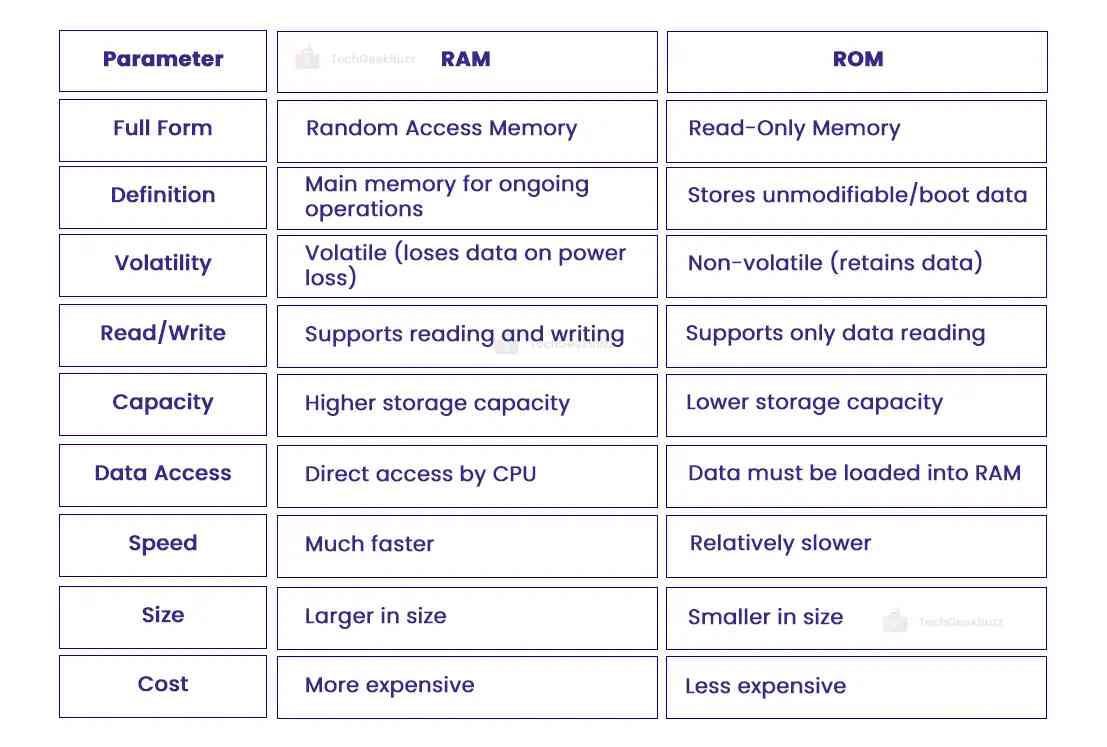
What is RAM?
RAM is an acronym for Random Access Memory. It is the main memory of a computer storing data, instructions, and the immediate results of processing. A CPU accesses RAM, as it holds essential data and instructions required to execute certain tasks or programs. After execution, the CPU stores immediate results in RAM to access them quickly for subsequent processing.
Random Access Memory is volatile memory that stores data as long as a computer is connected to the power supply. If the computer disconnects from the power supply, RAM loses all the data it holds.
Furthermore, RAM is a read/write memory, allowing reading and writing of data. It is much faster than other memory types. However, it can hold limited data.
What is ROM?
ROM stands for Read-Only Memory. As the name indicates, the data stored in ROM can only be read and not written. Hence, it generally stores data that needs no changes. For instance, it holds data and instructions required to start or turn on a computer called the start-up firmware. The starting up of a computer is generally called the booting process.
Read-only memory is non-volatile . This implies it does not lose the data or instructions it holds due to power loss. However, it is important to note that ROM, like a mask ROM or MROM, is fed with the necessary data and instructions at the time of manufacturing.
As technology has advanced over the years, different types of ROM have been introduced. These types allow the manipulation of data either electrically or using UV rays .
Difference Between RAM and ROM - A Head-to-Head Comparison
Now, you have a basic understanding of what RAM and ROM are. Let us now move on to compare these memory types and understand how they differ.
|
Parameters |
RAM |
ROM |
|
Full Form |
Random Access Memory |
Read-Only Memory |
|
Definition |
RAM is a computer’s main memory storing data or instructions a CPU requires to perform ongoing operations. |
ROM stores data or instructions that need no modifications. It generally stores instructions required for a computer’s booting process. |
|
Volatility |
It is volatile, losing all data once the power shuts down. |
It is non-volatile, as it retains data despite a power cut. |
|
Read/Write Operations |
RAM supports the reading and writing of data. |
ROM supports only the reading of data. |
|
Capacity |
The storage capacity of RAM is higher than ROM. |
The storage capacity of ROM is comparatively lower. |
|
Data Access |
A computer CPU can directly access data stored in RAM. |
The data in ROM must first be loaded into RAM to make it accessible for the CPU. |
|
Speed |
It is much faster than ROM. |
It is relatively slower. |
|
Size |
RAM is larger in size. |
ROM has a smaller size. |
|
Cost |
It is much more expensive. |
It is less expensive. |
|
Types |
|
|
Types of RAM
Two major types of RAM are Static RAM (SRAM) and Dynamic RAM (DRAM). Let us discuss them in detail below.
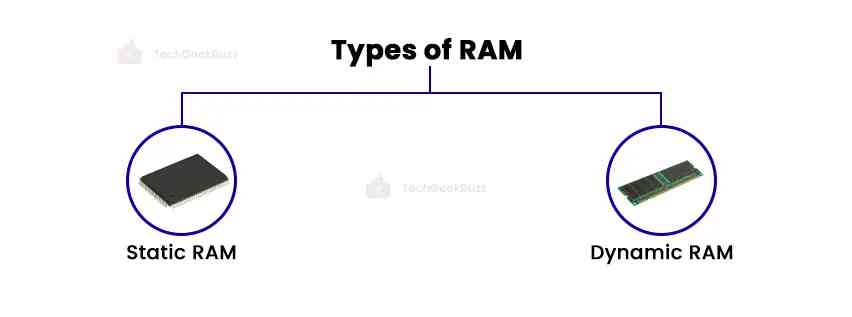
1. Static RAM (SRAM)
Static RAM leverages latching circuitry, i.e., flip-flops, to store data bits. It retains data bits as long as it gets the power supply. It does not require refreshing continuously, unlike DRAM. Hence, it is called static memory.
SRAM chips are composed of four transistors that are configured as two cross-coupled inverters. In addition, two extra transistors control access to a memory cell during read/write operations. This totals 6 transistors.
This type of RAM is faster than DRAM and is used as cache memory.
2. Dynamic RAM (DRAM)
Dynamic RAM utilizes memory cells consisting of a transistor and a capacitor to store data bits. It stores data on a capacitor. As the capacitor tends to lose data over a certain period of time, it needs periodic electrical refreshing.
DRAM chips are generally found in the main memory. They are slower than SRAM and consume less power supply.
Types of ROM
Let us now discuss different types of ROM here.

1. Mask ROM
Mask ROM is a type of ROM whose contents are pre-programmed during its production by an integrated circuit manufacturer. However, the memory contents are generally provided by consumers to manufacturers.
2. Programmable ROM (PROM)
PROM is also known as a one-time programmable ROM. It allows users to reprogram it only after manufacturing using a special PROM programmer device.
When you program PROM once after its manufacturing, the data in it stays permanently and cannot be changed. It generally stores low-level programs, such as firmware and microcode.
3. Erasable Programmable ROM (EPROM)
EPROM is a type of PROM whose data can be erased when a memory device is exposed to strong ultraviolet light for around 10 minutes or longer. Further, rewriting data into EPROM requires a larger amount of voltage than the usual one.
However, it is important to note that frequent exposure of EPROM to UV lights may wear it out quickly.
4. Electrically Erasable Programmable ROM (EEPROM)
EEPROM utilized electricity to erase data and rewrite data into it. Hence, this eliminates the need to remove the memory device from a computer.
Electrically Alterable ROM (EAROM) and flash memory are types of EEPROM. EAROM writes one bit at a time, which is time-consuming and requires a higher voltage than usual. On the other hand, flash memory is a modern EPROM that reads and writes data quickly.
Advantages and Disadvantages of RAM
The following are the benefits and drawbacks of RAM:
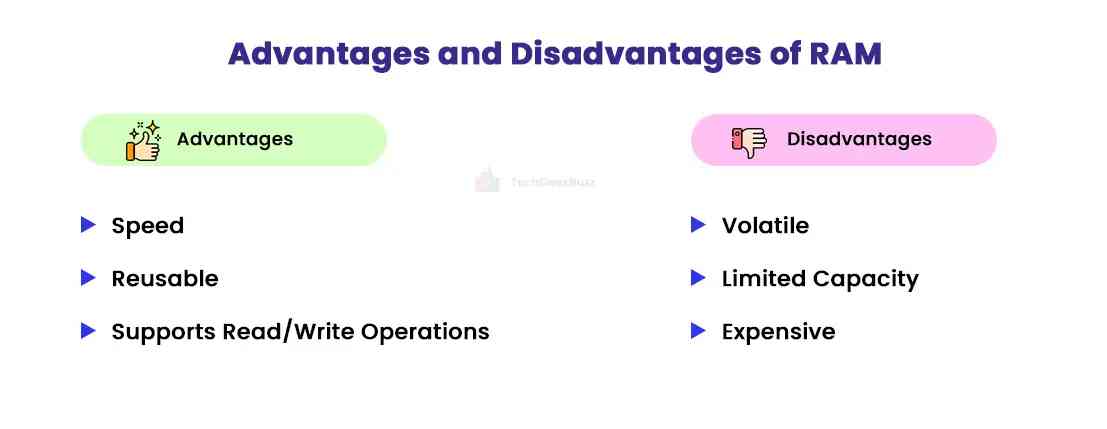
Advantages
- Speed: RAM is much faster than any other type of memory. Hence, it is ideal for storing data and instructions a CPU needs to carry out ongoing tasks.
- Reusable: RAM frequently changes the data it stores according to the CPU’s requirements. Hence, it is reusable.
- Supports Read/Write Operations: RAM allows the reading and writing of data, unlike ROM.
Disadvantages
- Volatile: RAM loses its contents as soon as a computer disconnects from the power supply.
- Limited Capacity: It has a limited storage capacity compared to other memory types, such as hard disks.
- Expensive: RAM is highly expensive.
Advantages and Disadvantages of ROM
Here are some remarkable pros and significant cons of ROM:
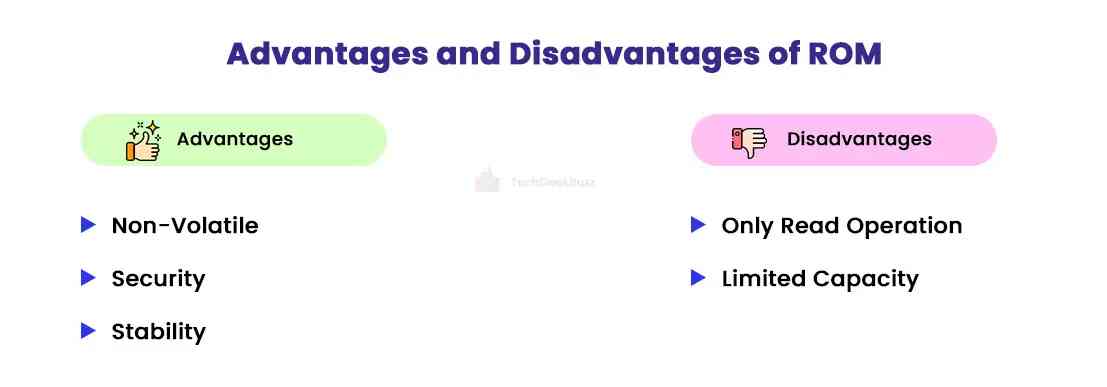
Advantages
- Non-Volatile: There is no fear of losing data stored in ROM, even if a computer shuts down or disconnects from the power supply. It stores data permanently.
- Security: As ROM is modified easily, it ensures data security and integrity.
- Stability: Persistent data storage makes ROM reliable for storing critical data.
Disadvantages
- Only Read Operation: ROM, like MROM, only supports the reading of data. Also, PROM allows one-time reprogramming. Hence, it supports the read operations.
- Limited Capacity: ROM also has a limited storage capacity.
Conclusion
This was all about the difference between RAM and ROM. Both are types of primary memory and have their own features. Though both share a similar purpose of storing data, they vary based on the type of data they store.
RAM stores data and instructions a computer’s CPU needs to execute current processes. In contrast, ROM stores data that needs no changes, such as firmware or microcode. RAM and ROM are equally important for a computer to function and process tasks.
If you are aware of any other differences between RAM and ROM, let us know in the comments.
People are also reading:
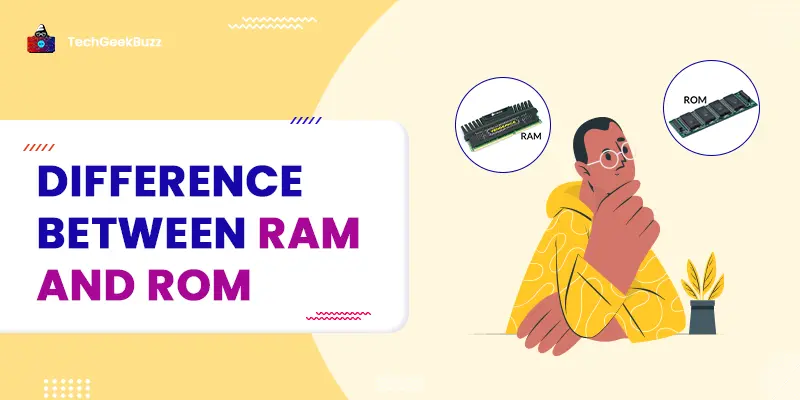

![What is an Assembler? [Definition, Working, & Types]](/media/new_post_images/What_is_Assembler.jpg)
![What is I/O? [Types, Examples, & Methods]](/media/new_post_images/What_is_I_O.webp)

Leave a Comment on this Post